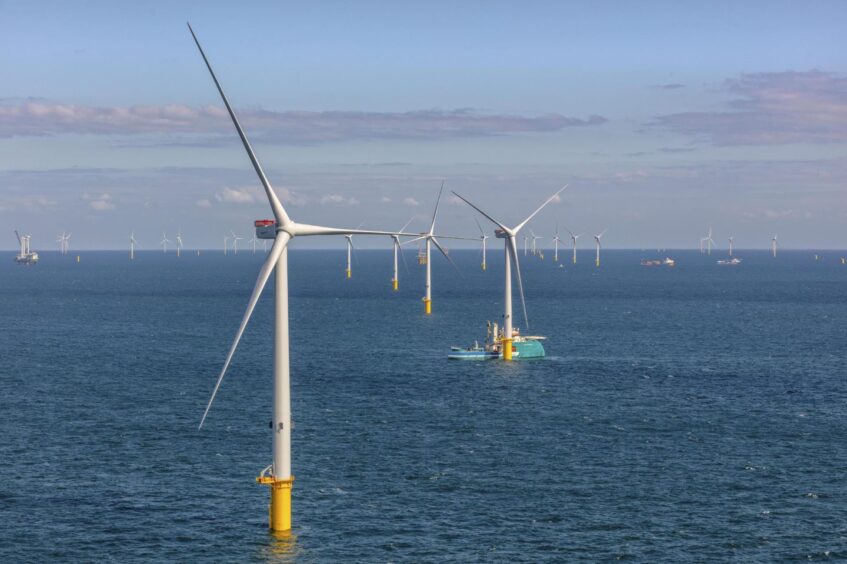 © Supplied by Flying Focus Aerial
© Supplied by Flying Focus Aerial It’s great to learn that investment in wind energy across Europe more than doubled last year compared to 2022, driven by record financing of North Sea offshore wind projects.
An easing of inflationary pressures, greater certainty in electricity markets, and improved tariff indexation by various EU member governments apparently created a more favourable investment climate; though financing conditions tightened.
And issues like “unhelpful” interventions in electricity markets by various governments were at least in part sorted out, according to overarching industry association WindEurope.
Net result – Europe invested a record €48bn in wind last year.
New investments offshore totalled €30bn, a sharp contrast to 2022 when almost no offshore wind farms were financed; not because of Brussels but factors largely outwith anyone’s control.
Onshore wind investments were comparable with previous years at €18bn. Though it is acknowledged that this is less than what is needed if Europe is going to deliver on its climate and energy objectives, this was still streets ahead of the UK where the central government has, for years, been dead set against onshore wind.
At least our neighbours did not have to suffer last year, the fools that inhabit the corridors of power in the UK; the bunch who have time and again made low carbon promises and then broken them.
I especially refer to those who conceived the AR5 offshore licensing round that totally failed to attract bids.
Last year the UK had planned to award up to 5GW of contracts for difference (CfDs) to offshore wind projects but no bids were forthcoming. Instead, developers warned that the prices offered by the government were too low.
Unfathomably, the price cap had been cut back to £44 per MWh, down from £46/MWh in the previous auction round, despite rampant price inflation.
And in the most recent UK Budget, the chancellor of the exchequer decided to not only try to grab yet more money off the now pariah oil and gas industry, but Jeremy Hunt also hacked off the brigade of carbon capture hopefuls who had been promised funding a year ago but never received it.
Contrasting with the AR5 failure, last year’s EU rebound was due to a relative stabilisation of costs after two years of significant inflation in steel and other commodity prices.
It was also thanks to an improvement in member government policies, with simplified permitting allowing for a larger projects pipeline. Additionally, said member governments’ growing recognition of the need to index auction tariffs and prices contributed to restoring investor confidence.
Europe also approved significantly more permits for new onshore wind farms in 2023 than in previous years, largely due to new rules on permitting. Contrast that with the UK situation, which remained confused; largely due to political chicanery.
The political outlook on wind energy changed too, with the EU and member governments recognising the industry’s challenges and the need for urgent support.
Net result: the EU Commission’s Wind Power Package in October outlined 15 concrete and immediate actions to strengthen the industry.
In December, 26 EU Member States and 300 companies signed the European Wind Charter in December, endorsing the Package and committing to take necessary actions.
Of the 27 member states, only Hungary failed to sign. Of course, Brexit Britain didn’t sign either as it is no longer an EU member.
The Package and Charter commit national Governments to support the European wind industry by improving auction design, fully indexing prices to reflect costs, tightening pre-qualification criteria, and providing clearer visibility on auction schedules and volumes for better industry planning.
The Package also commits the EU Commission to support the wind industry through the EU Innovation Fund.
The European Investment Bank (EIB) adopted a €5billion counter-guarantee scheme for wind energy manufacturing, enhancing access to finance for wind turbine manufacturers.
Basically, it’s about protecting Europe’s wind industry from “unfair trade practices” coming from Chinese manufacturers. UK, please note.
Furthermore, the recently agreed EU Net-Zero Industry Act (NZIA) enshrines in law the need to tighten pre-qualification criteria and sets a target of 36 GW a year for wind turbine manufacturing in Europe.
We don’t do turbine manufacturing in the UK; just bits and pieces.
But there’s one area where we’re all failing and this is a cause of deep concern not just here in the UK but right across Europe and it’s GRID! It seriously is the number one bottleneck issue and must be solved for all our sakes.
